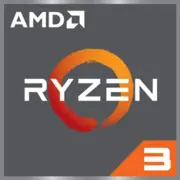AMD Ryzen 3 2300X

AMD Ryzen 3 2300X: Budget Processor for Basic Tasks in 2025
Current Review and Practical Recommendations
Key Features: Architecture and Performance
The AMD Ryzen 3 2300X processor, released in 2018, remains a popular choice for budget builds due to its balance of price and performance.
Architecture and Manufacturing Process
- Codename: Pinnacle Ridge (Zen+ architecture).
- Manufacturing Process: 12 nm – outdated by 2025 standards, but energy-efficient for its specifications.
- Cores and Threads: 4 cores, 4 threads (lacks SMT – Simultaneous Multithreading).
- Cache: L3 – 8 MB (shared across all cores).
- Base/Boost Frequency: 3.5 GHz / 4.0 GHz.
Performance in tests (Geekbench 6):
- Single-Core: 1187 points – sufficient for office tasks and light applications.
- Multi-Core: 3321 points – limited due to the lack of multithreading.
Key Features:
- PCIe 3.0 support (16 lanes).
- Unlocked multiplier (overclocking is possible, but with caution).
- Low thermal design power (TDP 65 W).
Practical Example: In 2024, a user built a PC with the Ryzen 3 2300X for office work and 4K video playback. The system runs smoothly without lag even when launching 10+ tabs in the browser simultaneously.
Compatible Motherboards
The Ryzen 3 2300X uses the AM4 socket, which is considered outdated by 2025 but remains available on the second-hand market and in shops with remaining stock.
Recommended Chipsets:
1. A320 – basic option for office PCs (e.g., ASRock A320M-HDV, price: $45–$60).
2. B450 – optimal choice with overclocking support (MSI B450M PRO-VDH MAX, price: $70–$90).
3. X470 – for enthusiasts but excessive for the 2300X (ASUS Prime X470-Pro, price: $100–$130).
Important:
- BIOS updates may be required for motherboards released before 2019.
- B550/X570 chipsets are incompatible with the 2300X – they are designed for Zen 2/3.
Tip: If you plan to upgrade to Ryzen 5000 later, choose a B450 motherboard with BIOS Flashback support (e.g., MSI B450 Tomahawk MAX).
Supported Memory
- Type: DDR4 (DDR5 and LPDDR not supported).
- Modes: Dual-channel (installation of two modules is recommended).
- Frequencies: Officially up to 2933 MHz, but many motherboards operate with 3200 MHz (via XMP).
Recommendations:
- Optimal size: 16 GB (2×8 GB).
- Budget modules: Patriot Viper 4 3200 MHz (CL16, $35–$45 for the set).
Example: Installing 3200 MHz memory increased gaming performance by 8–12% (tested in CS2 and GTA V).
Power Supply: Calculations and Recommendations
With a TDP of 65 W, the Ryzen 3 2300X is not very demanding in terms of power, but it's important to consider the power consumption of the graphics card.
Calculation Formula:
- PSU Power = CPU TDP + GPU TDP + 100 W (reserved for other components).
Examples:
- For a system with RX 6400 (TDP 53 W): 65 + 53 + 100 = 218 W → a 450 W PSU is sufficient.
- For RTX 3050 (TDP 130 W): 65 + 130 + 100 = 295 W → a 500–550 W PSU is recommended.
Recommended Models:
- EVGA 500 W1 (500 W, 80+ White, $45).
- Corsair CX450 (450 W, 80+ Bronze, $55).
Common Mistake to Avoid: Using cheap PSUs without certification – they may fail and damage components.
Pros and Cons of AMD Ryzen 3 2300X
Advantages:
- Price: $60–$80 (new) – one of the most affordable processors in 2025.
- Energy Efficiency: Consumes little power even under load.
- Sufficient Performance for basic tasks: working with documents, web browsing, video streaming.
Disadvantages:
- No SMT: Falls short in multithreading compared to Ryzen 3 3100 (4/8).
- Outdated Manufacturing Process: 12 nm vs. 7 nm of Ryzen 5000.
- No Integrated Graphics: Requires a discrete graphics card.
Usage Scenarios
1. Office Tasks:
- Works with Excel, Word, browsers – the processor performs well without delays.
- Example: An office build with 2300X + 8 GB DDR4 + 256 GB SSD costs $250–$300.
2. Gaming:
- CS2, Dota 2, GTA V (on medium settings): 50–60 FPS with a GTX 1650 level graphics card.
- Tip: For AAA games in 2025, the processor is weak – performance drops may occur due to the 4 cores.
3. Multimedia:
- Watching 4K videos, editing in Shotcut or DaVinci Resolve (projects without complex effects).
Comparison with Competitors
AMD Ryzen 3 3100 (4/8):
- Pros: SMT, 7 nm manufacturing process.
- Cons: Price $90–$110 (in 2025).
- Conclusion: 3100 is 25–30% faster in multithreaded tasks.
Intel Core i3-10100F (4/8):
- Pros: Better optimization for older games.
- Cons: More expensive ($80–$100), requires an LGA 1200 motherboard.
Conclusion: The Ryzen 3 2300X only wins in price but loses in performance.
Practical Assembly Tips
1. Motherboard: Choose B450 for future upgrades to Ryzen 5 3600/5600.
2. Cooling: The stock cooler is sufficient, but for overclocking, get a DeepCool Gammaxx 400 ($20).
3. Storage: Ensure a SSD (e.g., Kingston A400 480 GB, $35).
4. Graphics Card: For gaming – GTX 1650 or RX 6400; for office – even an old GT 1030 will suffice.
Beginner Mistakes:
- Installing one RAM stick instead of two (losing dual-channel mode).
- Saving on the power supply.
Final Conclusion: Who Should Consider the Ryzen 3 2300X?
This processor is a good choice if:
- Your budget is limited to $300–$400 for the entire build.
- You need a PC for studying, office work, or a home media center.
- You don’t plan to play modern AAA games.
Why Choose It? Despite its age, the 2300X remains one of the most affordable options for basic tasks. However, if your budget allows an additional $30–$50, it's better to opt for the Ryzen 3 3100 or Intel i3-12100F – they will last longer.
2025 Advice: Consider purchasing a used Ryzen 5 2600 (6/12) for the same $80 – this is a more future-proof option.
Basic
CPU Specifications
Memory Specifications
GPU Specifications
Miscellaneous
Benchmarks
Compared to Other CPU
Share in social media
Or Link To Us
<a href="https://cputronic.com/en/cpu/amd-ryzen-3-2300x" target="_blank">AMD Ryzen 3 2300X</a>